Book Reviews
By Amy Nelson
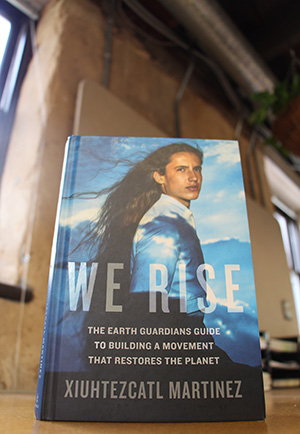
Review by Amy Nelson
“I don’t ever want to have to be something that I’m not to make a difference in the world,” writes seventeen-year-old Xiuhtezcatl Martinez in the prologue to his new book, We Rise: The Earth Guardians Guide to Building a Movement that Restores the Planet.
He writes this after sharing a personal narrative of his trip to New York City at the age of 15 to address the United Nations General Assembly in the months leading up to the Paris climate talks. Reading this anecdote is inspiring—and fun. One can easily imagine Martinez’ teenage eye rolling in reaction to the “ridiculous” amount of security, the “lifeless room,” and the unengaging talks he must sit through while waiting for his turn at the podium. When he forgivingly laughs off the UN representative who cannot pronounce his name, we laugh with him. We know from the story that he has defied his mother’s urgings to memorize his speech. When he ends up stunning and confusing the audience by beginning his speech with a prayer in the language of his Mexica Aztec ancestry-for which there is no UN translator-and “freestyling” the rest, we raise a virtual fist in the air and cheer this refreshing, young voice in the environmental movement. It is as authentic as they come, and it is what makes this book a joy to read.
After the 2016 election, Martinez saw a great deal of anger among his peers, but he also recognized a lack of knowledge about environmental issues. “A lot of people in my generation were going to rallies and chanting,” he said, “but they didn’t really know what was going on.” This book is his attempt to fill that knowledge gap and provide a path for people to direct their anger toward action.
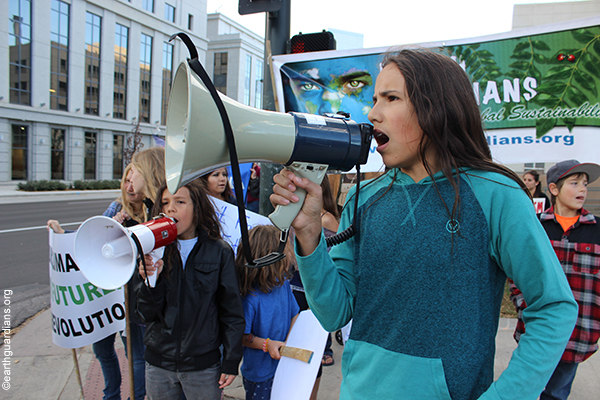 In the first chapters, Martinez shares the story of his own call to activism, and the influence of his Mexica Aztec ancestry. We also learn about his earliest days in the Earth Guardians organization, which allows us to see the environmental movement through the utterly refreshing eyes of a passionate and hopeful child. We can feel, for example, the thrill of an 11-year-old who boy who is pedaling his bike alongside 500 other people on a closed off, three-lane highway en route to a mass sunflower planting in protest of a coal plant in his community. That thrill—of following one’s passion, finding community, and taking creative action—is, according to Martinez, an essential ingredient for successful activism, regardless of one’s age or the scale of one’s efforts. It is also fun.
In the first chapters, Martinez shares the story of his own call to activism, and the influence of his Mexica Aztec ancestry. We also learn about his earliest days in the Earth Guardians organization, which allows us to see the environmental movement through the utterly refreshing eyes of a passionate and hopeful child. We can feel, for example, the thrill of an 11-year-old who boy who is pedaling his bike alongside 500 other people on a closed off, three-lane highway en route to a mass sunflower planting in protest of a coal plant in his community. That thrill—of following one’s passion, finding community, and taking creative action—is, according to Martinez, an essential ingredient for successful activism, regardless of one’s age or the scale of one’s efforts. It is also fun.
“However serious I may appear to be in front of the UN or while giving a TedTalk,” he writes, “I’m still just a 17-year-old kid trying to make a difference, while having a hell of a good time doing it.”
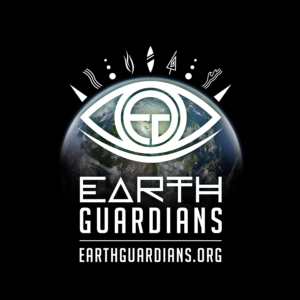 Martinez concludes these early chapters by encouraging readers to start their own Earth Guardian crews and providing step-by-step instructions on how to do so. He also offers general guidance for people seeking a path to activism, and recommends tools for learning more about elected officials.
Martinez concludes these early chapters by encouraging readers to start their own Earth Guardian crews and providing step-by-step instructions on how to do so. He also offers general guidance for people seeking a path to activism, and recommends tools for learning more about elected officials.
The middle section of the book is organized into chapters devoted to specific issues, such as ocean health, fracking, rainforest destruction, and environmental injustice. Not surprisingly, climate change, which has its own chapter, is the thread that links them all.
Each chapter begins with a presentation of up-to-date information and resources related to the issue. Here Martinez includes the sobering factoids we have come to expect in environmental literature, but he does so with a voice that is uniquely honest, informal, and, well…teenaged. He also weaves in illustrative anecdotes from his own life or the lives of people he knows. The result is that the issues become humanized and relatable to readers whose lives may not yet have been directly impacted by them. After sharing statistics about the staggering number of people projected to be displaced by climate change, for example, he relates the story of a young friend who lost his home to one of Colorado’s increasingly frequent wildfires. “He told me that as the wildfires spread in the direction of his house,” writes Martinez of his friend, “they got their dogs, their favorite Legos, and a few prized possessions, and just left.” To someone living in an area not prone to wildfires, the whole idea of a wildfire may be inconceivable. But who cannot imagine a young boy clutching his treasured Legos as his home burns to the ground?
These issue-themed chapters also include examples of activist efforts to address the issue, and guidance for readers who want to take action themselves. Woven into this guidance—and throughout the book—is the message that activism is essentially an act of love, and that it is powerful at any scale.
Peppered throughout the book are transcripts of conversations Martinez has held with prominent players in various facets of the environmental movement. These include particularly riveting discussions with Captain Paul Watson, founder of the Sea Shepherd Conservation Society, actress Shailene Woodley, and commentator Van Jones.
In the final portion of the book, labeled “The Game Plan,” Martinez offers guidance—both general and specific—for growing the movement. He calls for “intersectional movements” that follow nature’s model of diversity and offers advice for elevating the voices of the young and disenfranchised in a meaningful, authentic way.
Martinez motivates young readers by reminding them of the advantages of their generation: its fearlessness, its ability to tell powerful stories, and its mastery of social media and other non-traditional tools of activism. “We are awake, connected, and equipped to leave a remarkable legacy,” he writes.
Martinez concludes the book with some text-book style tips for understanding the range of opinions on an issue, crafting a public narrative, and developing a campaign strategy. While these nuggets of instruction are helpful, the most powerful thing about We Rise is Martinez’ voice. Its earnestness, honesty, and humility will make you want to be a better person. Its straight-up, no-B.S. purity will make you wonder why you waited so long.
Two books to inspire our youngest generation
 Reviews by Jennifer Dowdell, Landscape Ecological Planner and Designer
Reviews by Jennifer Dowdell, Landscape Ecological Planner and Designer
For some of us, our first taste of activism comes from witnessing our parents or leaders in our community. Others may be inspired by someone we learn about at school or in our places of worship. One of the greatest sources of inspiration are the books we read as children. We have met a host of incredible youth activists in this issue of Leaf Litter to inspire and inform our work. To complement this, we sought to find books for our youngest generation that highlight the issues that inform our work and the stories of people who embody a deep connection to environmental justice and scientific inquiry. Here are two such books that struck our fancy and are kid-approved.
North: The Amazing Story of Arctic Migration by Nick Dowson (Illustrated by Patrick Benson)
2013 – Candlewick Press
(Ages 7-10; Grades 2-5)
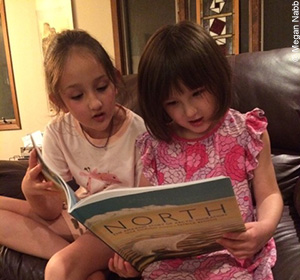 North is a beautifully rendered story of the wildlife species that take part in the annual summer migration to the Arctic. The book takes the reader on this journey too, starting in the winter when only the polar bear and arctic fox are present, and guiding us through the seasons and around the globe with the various summer residents of the Northern-most point on Earth. Using narrative that is accessible and engaging, Nick Dowson takes the reader on this global voyage following a host of species, including the godwits, terns, gray whales, Pacific walrus, gray wolves, and caribou, from their winter homes northward. He describes the warmth that spurs on new growth, the distinct behaviors of wildlife as they travel, and the changing landscape that provides food and shelter for young and old alike.
North is a beautifully rendered story of the wildlife species that take part in the annual summer migration to the Arctic. The book takes the reader on this journey too, starting in the winter when only the polar bear and arctic fox are present, and guiding us through the seasons and around the globe with the various summer residents of the Northern-most point on Earth. Using narrative that is accessible and engaging, Nick Dowson takes the reader on this global voyage following a host of species, including the godwits, terns, gray whales, Pacific walrus, gray wolves, and caribou, from their winter homes northward. He describes the warmth that spurs on new growth, the distinct behaviors of wildlife as they travel, and the changing landscape that provides food and shelter for young and old alike.
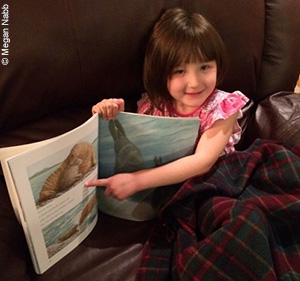 While writing for children, Dowson does an incredible job of integrating many lessons, fit for any age, of the interconnected nature of our ecosystems. His narrative is accompanied by imagery done in sumptuous watercolor and subtle pencil strokes by artist Patrick Benson. The images evoke the splendor of the Arctic and the incredible variety of wildlife that journey from places as disparate as Mexico, New Zealand, Canada, and the South Pole.
While writing for children, Dowson does an incredible job of integrating many lessons, fit for any age, of the interconnected nature of our ecosystems. His narrative is accompanied by imagery done in sumptuous watercolor and subtle pencil strokes by artist Patrick Benson. The images evoke the splendor of the Arctic and the incredible variety of wildlife that journey from places as disparate as Mexico, New Zealand, Canada, and the South Pole.
Reading this book with my niece, C, I couldn’t help but be drawn into the narrative and feel a sense of wonder and renewed respect for the Arctic and its importance in so many creatures’ lifecycles. C was most impressed with the gray whales that swim 5,000 miles over eight weeks without feeding! She even said she’d be interested in visiting the Arctic, “but only in the summer or spring, definitely not in winter.” Best read aloud, this book is truly a work of art and an inspiration for any would-be explorer or scientist!
I am Jane Goodall by Brad Meltzer (Illustrated by Christopher Eliopoulos)
2016 – Dial, An Imprint of Penguin Random House LLC
(Ages 5-8, Grades K -3.)
In I am Jane Goodall, the eponymous narrative exclaims, “When one of us is in trouble—be it human, creature, or nature itself—we must reach out and help. When we do, we build a bridge that carries us all.” When asked what about this book she liked, after we’d read it together a few times over, my niece E shyly whispered, “She found them.” “She found whom?” I pressed. “The chimpanzees,” E said.
It’s true, Jane found the chimpanzees, and along the way she found a hungry curiosity for the natural world, a love of reading, a deep respect for wild animals—especially the chimpanzees, and her vocation in scientific observation, research, education, and advocacy. Through this charming book aimed at young readers we learn the story of Jane Goodall’s life. This tiny tome is filled with gentle but strong lessons about family, tenacity, feminism, scientific inquiry, and the universality of our shared experiences.
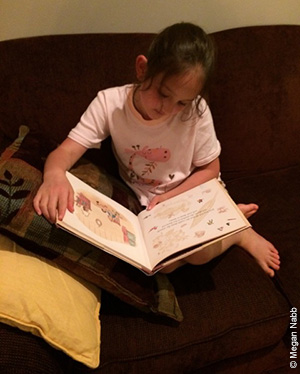 Anecdotes from Jane’s childhood all the way to the moment she met David Greybeard as a young researcher in Tanzania, are brought to life in colorful illustrations and direct quotes from Ms. Goodall herself.
Anecdotes from Jane’s childhood all the way to the moment she met David Greybeard as a young researcher in Tanzania, are brought to life in colorful illustrations and direct quotes from Ms. Goodall herself.
Part of a series called Ordinary People Change the World, this is a must-read for kids. It opens up a world of possibilities for activism and action, curiosity and collaboration. As Jane puts it at the end of her story: “You cannot get through a single day without having an impact on the world around you. What you do makes a difference and you have to decide what kind of difference you want to make.”
What’s more, this book concludes with a trove of resources and extras including information about Jane’s youth activism network called Roots and Shoots and her nonprofit, the Jane Goodall Institute. Roots and Shoots, founded in 1991, connects youths in 130+ countries through more than 150,000 groups of young people working for positive change for animals, the environment, and communities. The website explains that Roots and Shoots was founded in order to empower and encourage youth of all ages to pursue their passion, mobilize their peers, and become the leaders our world needs in order to ensure a better future. It includes easily-accessible, relevant, and immediately-applicable actions and activities for students of all ages.
Still more goodies are available for adults and children alike:
- In the introduction to a new Master Class being offered, Jane Goodall explains that “I went to Africa as a scientist, and left the jungle as an activist.” This master class session is now available online.
- A new documentary, JANE, uses previously unseen footage of Jane at work in Tanzania in the 1960’s, with a score by Phillip Glass. The film premiered at the Toronto Film Festival and will be out in select theaters October 20th.. Check the National Geographic website for more information and read about the exclusive opening screening.
Happy reading!
 He writes this after sharing a personal narrative of his trip to New York City at the age of 15 to address the United Nations General Assembly in the months leading up to the Paris climate talks. Reading this anecdote is inspiring—and fun. One can easily imagine Martinez’ teenage eye rolling in reaction to the “ridiculous” amount of security, the “lifeless room,” and the unengaging talks he must sit through while waiting for his turn at the podium. When he forgivingly laughs off the UN representative who cannot pronounce his name, we laugh with him. We know from the story that he has defied his mother’s urgings to memorize his speech. When he ends up stunning and confusing the audience by beginning his speech with a prayer in the language of his Mexica Aztec ancestry-for which there is no UN translator-and “freestyling” the rest, we raise a virtual fist in the air and cheer this refreshing, young voice in the environmental movement. It is as authentic as they come, and it is what makes this book a joy to read.
He writes this after sharing a personal narrative of his trip to New York City at the age of 15 to address the United Nations General Assembly in the months leading up to the Paris climate talks. Reading this anecdote is inspiring—and fun. One can easily imagine Martinez’ teenage eye rolling in reaction to the “ridiculous” amount of security, the “lifeless room,” and the unengaging talks he must sit through while waiting for his turn at the podium. When he forgivingly laughs off the UN representative who cannot pronounce his name, we laugh with him. We know from the story that he has defied his mother’s urgings to memorize his speech. When he ends up stunning and confusing the audience by beginning his speech with a prayer in the language of his Mexica Aztec ancestry-for which there is no UN translator-and “freestyling” the rest, we raise a virtual fist in the air and cheer this refreshing, young voice in the environmental movement. It is as authentic as they come, and it is what makes this book a joy to read.
After the 2016 election, Martinez saw a great deal of anger among his peers, but he also recognized a lack of knowledge about environmental issues. “A lot of people in my generation were going to rallies and chanting,” he said, “but they didn’t really know what was going on.” This book is his attempt to fill that knowledge gap and provide a path for people to direct their anger toward action.
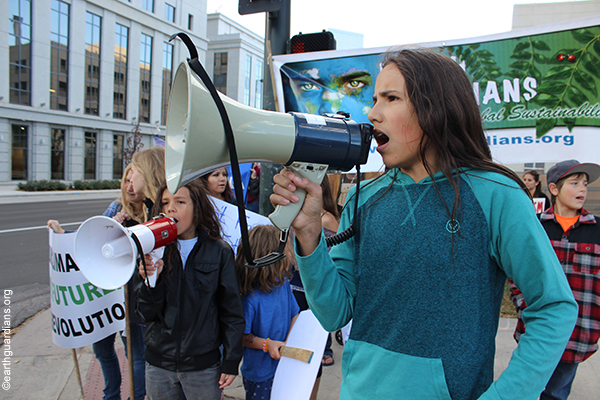
In the first chapters, Martinez shares the story of his own call to activism, and the influence of his Mexica Aztec ancestry. We also learn about his earliest days in the Earth Guardians organization, which allows us to see the environmental movement through the utterly refreshing eyes of a passionate and hopeful child. We can feel, for example, the thrill of an 11-year-old who boy who is pedaling his bike alongside 500 other people on a closed off, three-lane highway en route to a mass sunflower planting in protest of a coal plant in his community. That thrill—of following one’s passion, finding community, and taking creative action—is, according to Martinez, an essential ingredient for successful activism, regardless of one’s age or the scale of one’s efforts. It is also fun.
Martinez concludes these early chapters by encouraging readers to start their own Earth Guardian crews and providing step-by-step instructions on how to do so. He also offers general guidance for people seeking a path to activism, and recommends tools for learning more about elected officials.
The middle section of the book is organized into chapters devoted to specific issues, such as ocean health, fracking, rainforest destruction, and environmental injustice. Not surprisingly, climate change, which has its own chapter, is the thread that links them all.
Each chapter begins with a presentation of up-to-date information and resources related to the issue. Here Martinez includes the sobering factoids we have come to expect in environmental literature, but he does so with a voice that is uniquely honest, informal, and, well…teenaged. He also weaves in illustrative anecdotes from his own life or the lives of people he knows. The result is that the issues become humanized and relatable to readers whose lives may not yet have been directly impacted by them. After sharing statistics about the staggering number of people projected to be displaced by climate change, for example, he relates the story of a young friend who lost his home to one of Colorado’s increasingly frequent wildfires. “He told me that as the wildfires spread in the direction of his house,” writes Martinez of his friend, “they got their dogs, their favorite Legos, and a few prized possessions, and just left.” To someone living in an area not prone to wildfires, the whole idea of a wildfire may be inconceivable. But who cannot imagine a young boy clutching his treasured Legos as his home burns to the ground?
These issue-themed chapters also include examples of activist efforts to address the issue, and guidance for readers who want to take action themselves. Woven into this guidance—and throughout the book—is the message that activism is essentially an act of love, and that it is powerful at any scale.
Peppered throughout the book are transcripts of conversations Martinez has held with prominent players in various facets of the environmental movement. These include particularly riveting discussions with Captain Paul Watson, founder of the Sea Shepherd Conservation Society, actress Shailene Woodley, and commentator Van Jones.
In the final portion of the book, labeled “The Game Plan,” Martinez offers guidance—both general and specific—for growing the movement. He calls for “intersectional movements” that follow nature’s model of diversity and offers advice for elevating the voices of the young and disenfranchised in a meaningful, authentic way.
Martinez motivates young readers by reminding them of the advantages of their generation: its fearlessness, its ability to tell powerful stories, and its mastery of social media and other non-traditional tools of activism. “We are awake, connected, and equipped to leave a remarkable legacy,” he writes.
Martinez concludes the book with some text-book style tips for understanding the range of opinions on an issue, crafting a public narrative, and developing a campaign strategy. While these nuggets of instruction are helpful, the most powerful thing about We Rise is Martinez’ voice. Its earnestness, honesty, and humility will make you want to be a better person. Its straight-up, no-B.S. purity will make you wonder why you waited so long.
Review by Amy Nelson, Leaf Litter editor
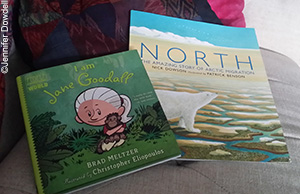 North is a beautifully rendered story of the wildlife species that take part in the annual summer migration to the Arctic. The book takes the reader on this journey too, starting in the winter when only the polar bear and arctic fox are present, and guiding us through the seasons and around the globe with the various summer residents of the Northern-most point on Earth. Using narrative that is accessible and engaging, Nick Dowson takes the reader on this global voyage following a host of species, including the godwits, terns, gray whales, Pacific walrus, gray wolves, and caribou, from their winter homes northward. He describes the warmth that spurs on new growth, the distinct behaviors of wildlife as they travel, and the changing landscape that provides food and shelter for young and old alike.
North is a beautifully rendered story of the wildlife species that take part in the annual summer migration to the Arctic. The book takes the reader on this journey too, starting in the winter when only the polar bear and arctic fox are present, and guiding us through the seasons and around the globe with the various summer residents of the Northern-most point on Earth. Using narrative that is accessible and engaging, Nick Dowson takes the reader on this global voyage following a host of species, including the godwits, terns, gray whales, Pacific walrus, gray wolves, and caribou, from their winter homes northward. He describes the warmth that spurs on new growth, the distinct behaviors of wildlife as they travel, and the changing landscape that provides food and shelter for young and old alike.
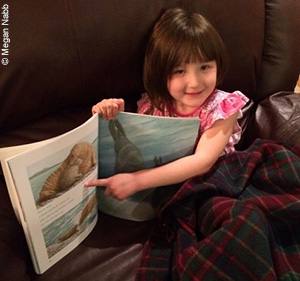 While writing for children, Dowson does an incredible job of integrating many lessons, fit for any age, of the interconnected nature of our ecosystems. His narrative is accompanied by imagery done in sumptuous watercolor and subtle pencil strokes by artist Patrick Benson. The images evoke the splendor of the Arctic and the incredible variety of wildlife that journey from places as disparate as Mexico, New Zealand, Canada, and the South Pole.
While writing for children, Dowson does an incredible job of integrating many lessons, fit for any age, of the interconnected nature of our ecosystems. His narrative is accompanied by imagery done in sumptuous watercolor and subtle pencil strokes by artist Patrick Benson. The images evoke the splendor of the Arctic and the incredible variety of wildlife that journey from places as disparate as Mexico, New Zealand, Canada, and the South Pole.
Reading this book with my niece, C, I couldn’t help but be drawn into the narrative and feel a sense of wonder and renewed respect for the Arctic and its importance in so many creatures’ lifecycles. C was most impressed with the gray whales that swim 5,000 miles over eight weeks without feeding! She even said she’d be interested in visiting the Arctic, “but only in the summer or spring, definitely not in winter.” Best read aloud, this book is truly a work of art and an inspiration for any would-be explorer or scientist!
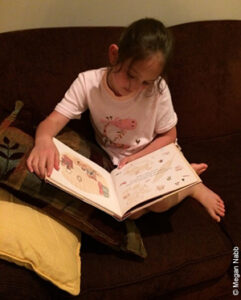 In I am Jane Goodall, the eponymous narrative exclaims, “When one of us is in trouble—be it human, creature, or nature itself—we must reach out and help. When we do, we build a bridge that carries us all.” When asked what about this book she liked, after we’d read it together a few times over, my niece E shyly whispered, “She found them.” “She found whom?” I pressed. “The chimpanzees,” E said.
In I am Jane Goodall, the eponymous narrative exclaims, “When one of us is in trouble—be it human, creature, or nature itself—we must reach out and help. When we do, we build a bridge that carries us all.” When asked what about this book she liked, after we’d read it together a few times over, my niece E shyly whispered, “She found them.” “She found whom?” I pressed. “The chimpanzees,” E said.
It’s true, Jane found the chimpanzees, and along the way she found a hungry curiosity for the natural world, a love of reading, a deep respect for wild animals—especially the chimpanzees, and her vocation in scientific observation, research, education, and advocacy. Through this charming book aimed at young readers we learn the story of Jane Goodall’s life. This tiny tome is filled with gentle but strong lessons about family, tenacity, feminism, scientific inquiry, and the universality of our shared experiences.
Anecdotes from Jane’s childhood all the way to the moment she met David Greybeard as a young researcher in Tanzania, are brought to life in colorful illustrations and direct quotes from Ms. Goodall herself.
Part of a series called Ordinary People Change the World, this is a must-read for kids. It opens up a world of possibilities for activism and action, curiosity and collaboration. As Jane puts it at the end of her story: “You cannot get through a single day without having an impact on the world around you. What you do makes a difference and you have to decide what kind of difference you want to make.”
What’s more, this book concludes with a trove of resources and extras including information about Jane’s youth activism network called Roots and Shoots and her nonprofit, the Jane Goodall Institute. Roots and Shoots, founded in 1991, connects youths in 130+ countries through more than 150,000 groups of young people working for positive change for animals, the environment, and communities. The website explains that Roots and Shoots was founded in order to empower and encourage youth of all ages to pursue their passion, mobilize their peers, and become the leaders our world needs in order to ensure a better future. It includes easily-accessible, relevant, and immediately-applicable actions and activities for students of all ages.
Still more goodies are available for adults and children alike:
- In the introduction to a new Master Class being offered, Jane Goodall explains that “I went to Africa as a scientist, and left the jungle as an activist.” This master class session is now available online.
- A new documentary, JANE, uses previously unseen footage of Jane at work in Tanzania in the 1960’s, with a score by Phillip Glass. The film premiered at the Toronto Film Festival and will be out in select theaters October 20th.. Check the National Geographic website for more information and read about the exclusive opening screening.
Happy reading!
Reviews by Jennifer Dowdell, Landscape Ecological Planner and Designer
